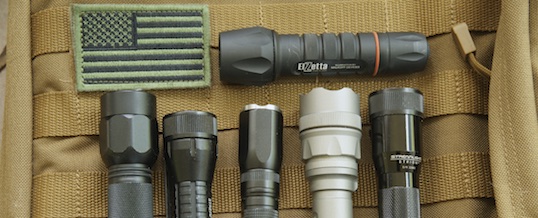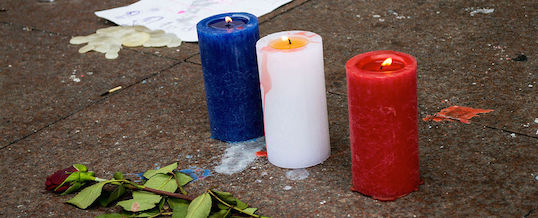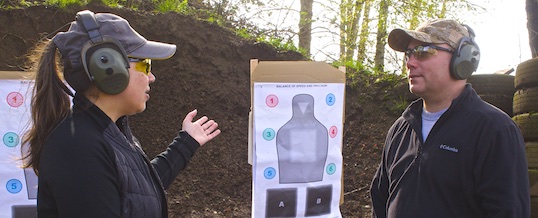
Your defensive flashlight: lithium or alkaline? You might be surprised which one I prefer!
In the last couple of years I’ve become a big proponent of the high intensity compact flashlight as a personal security and defense tool. I use those words specifically because the flashlight is the perfect example of a multi-use device: it serves as an early warning system, by allowing you to detect dangers before you get to them — or they get to you; it sets up a psychological barrier against a human threat, by showing that you’re in control of the darkness that attackers often exploit; it makes a good distraction tool, because you can use the beam to disorient a threat while you either leave the area or prepare to defend yourself with a greater level of force; and, properly wielded, can be an effective impact or control tool if you end up in contact with your attacker.
(Of course, it’s also a valuable tool to have if you’re forced to use a firearm in self defense, as it allows you to positively identify that the person you’re pointing your gun at is really a threat. So many mistaken identity shootings — many of them teenaged children of the person wielding the gun — could have been prevented if the shooter had simply used a flashlight to make sure that the other person was really an attacker!)
As a non-lethal-force tool, the flashlight is low profile and allowed everywhere; I’ve carried my defensive flashlight into areas where guns, knives, and “tactical” pens were not allowed and routinely confiscated. It is, I think, the most important defensive tool you can carry simply because of its wide range of application and availability.
(It’s even better if you can get to one of Julie Loeffler’s “Light Then Fight!” flashlight defense courses. I’ve had the privilege of one-on-one instruction with Julie and learned a lot about the use of the flashlight as an active defense tool. Her methods, coupled with my previous Kubaton training and my experience in the use of light as a distraction and control device, have given me a good skillset in using a flashlight to defend myself.)
In short, if you’re going to be prepared for a wide range of threats a high intensity flashlight is a necessity. If you’re using it properly, it’s going to see a surprising amount of run time. Here’s the problem: run time consumes batteries, and batteries for good flashlights are expensive. But do they need to be?
You can skip the next few paragraphs if you’re not into history or technology, but back in the olden days all portable flashlights used bulbs. Not LED “bulbs”, but real bulbs where the batteries heated a filament to the point that it glowed incandescently. In fact, that’s the term used for a bulb with a filament: incandescent. LED lights didn’t yet exist.
Making a piece of thin metal wire glow brightly enough to be useful requires energy and the brighter you want that bulb to glow the more energy you need to use. In the early days of flashlight technology, carbon-zinc batteries provided very low current at relatively low voltages. (For the technically minded, the current was limited by the high internal resistance of the battery.) Alkaline batteries were a big improvement, as they could provide higher current at the same voltages as their carbon-zinc ancestors.
The problem was that even the alkaline batteries, as big an improvement as they were, still didn’t provide enough current to make a bulb glow really brightly. You might remember, or perhaps have seen old pictures, of the big “police” flashlights that were common prior to about 1990. They used 3, 4, 5, or even 6 alkaline “D” cell batteries to boost the voltage high enough to produce brighter light, which still wasn’t all that bright because the batteries themselves limited how much current could be delivered. The simple reality was that no matter what anyone did, there was only so much light that could be produced by a bulb running on the batteries available.
In the 1980s Laser Products, who later changed their name to the far more recognizable SureFire, produced the first high-intensity portable flashlight. Their palm-sized marvel put out a whopping 60 lumens of light, compared to the 25 lumens (or thereabouts) of even the biggest of the flashlights then in police service. It’s hard to describe just how amazing that was! Having a flashlight that put out three or four TIMES the light of anything else but would fit easily in a pocket was absolutely amazing.
The secret was the new battery they were using. The company used two cells which utilized chemistry built on lithium. These lithium batteries were not only more powerful, as a single cell put out 3 volts instead of the 1.5 volts all older cells produced, but also delivered that voltage at a much higher current. This allowed them to make a small bulb burn far brighter, and combined with a more efficient reflector arrangement produced a room-filling light that had to be seen to be believed. Before anyone knew it, police and military had adopted the new lights and batteries. The lithium cell became synonymous with “tactical” flashlights simply because they made the designs possible.
Fast-forward to today; modern LEDs have long since replaced the old incandescent bulbs. Today’s lights put out 300% more light in a smaller package than those first high-intensity incandescent lights and, what’s more, they do so with far less battery drain. We’ve learned to produce lithium-level light without needing to use lithium cells! Still, most of the “serious” or “tactical” flashlights you’ll find today are still using those lithium cells — and they may not be the best choice for a modern defensive tool.
First, lithium cells are slightly more dangerous than their alkaline counterparts; if accidentally shorted they can explode, and sometimes they just burst for no apparent reason. It’s easy to find examples on the ‘net of burst lithium cells (and flashlights.) Injuries, while thankfully rare, have occurred.
Second, and more importantly to this discussion, they’re expensive. A quality 123-size lithium cell (and trust me, you want to buy quality lithium batteries!) will cost around $1 these days, and that’s if you plan your purchases. If you’re caught somewhere and need to buy cells from a local store, you may find they cost you $2 or even $3 each!
Here’s the kicker: to make the flashlight a true part of your total self-defense strategy you need to use it. Even as efficient as most LED lights are, if you use the light you’ll go through lithium batteries— and I’ve seen more than one person hesitate to use their flashlight properly or as frequently as they should because they didn’t want to burn through yet another set of those expensive lithium cells.
This brings us to the question: do you need a lithium-based flashlight? Personally, I don’t think so. In fact, though I have a number of high-end lithium lights the ones that I carry every single day use the ubiquitous AA cell.
Today’s AA-powered lights will easily put out 180-200 lumens of light on alkaline batteries, and a bit more using common rechargeable NiMH batteries like the well-known Eneloop rechargeables. That’s more than enough to spot threats at plausible distances, and certainly enough to distract or affect their vision temporarily.
I speak from experience; I used one of the old 60-lumen incandescent lights to drive off two miscreants in two separate incidents: one was a car prowler, the other was a scruffy gentleman who was attempting to “interview” me as a prelude to an attack. In both cases that beam, relatively weak by today’s standards, was enough to cause them to bring their hands to their faces and back away while making copious excuses as to how they were “not doin’ anything”!
[frame style=”modern” image_path=”https://www.grantcunningham.com/wp-content/uploads/2015/11/Quark_AA_flashlight_with_eneloops.jpg” link_to_page=”” target=”” description=”” float=”” lightbox=”” lightbox_group=”” size=”two_col_large”]
I believe that we’ve now reached a point of “enough” with regards to output, and it’s possible to get there using common, readily available, and cheap batteries. Today I carry a AA-powered light that produces three times that amount of illumination and the effect on the subject is even more profound. The picture above is the light and batteries I actually have on my person, every day, no matter where I am; it makes a superb illumination tool, very bright with a beautiful smooth beam — everything you need in a light!
Another reason I like the AA-cell lights is because they’re slim and long. They make excellent impact tools (particularly the way that Julie Loeffler teaches) because they protrude significantly beyond the hand when clenched in a fist. They’re also long enough to make a good Kubaton for pain compliance techniques; the shorter and fatter lithium lights are noticeably harder to employ in either role. My personal light, using two AA batteries, is big enough to use as a solid defensive tool yet still small enough to fit into the front pocket of my jeans or slacks. That’s why it goes everywhere I do!
The bottom line is that we no longer need to use expensive lithium cells just because we did in the old days. I’m a fan of today’s modern, high efficiency AA-powered flashlights, enough so that I carry one every day. My lithium lights rarely see use, which is great for my bank account! Whether you’re buying your first defensive flashlight or your tenth I suggest taking a hard look at the better-quality AA-powered lights on the market. I think you’ll like what you see.
– Grant Cunningham
- Posted by Grant Cunningham
- On November 30, 2015



